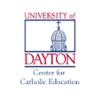Center for Catholic Education at UD

Religious Education Research
By Victoria Schoen
For the Philosophy of Education class that I took this year at UD, we were asked to find a book about the philosophy of education in relation to our teaching concentration(s). My passion is for teaching theology, so I found the book “Contemporary Approaches to Christian Education” by Jack L. Seymour and Donald E. Miller in order to complete the assignment. I really enjoyed reading this book and writing this paper, so I want to share some of the main points I wrote about with you, our cherished readers!
Jack L. Seymour and Donald E. Miller wrote the book “Contemporary Approaches to Christian Education” in order to discuss the different ways that religious education is now being presented in schools and/or parishes. In their first chapter, they say “the hope is that this volume will stimulate dialogue among Christian educators as to the future shape of the discipline” (11). Religious education, specifically Christian education, has many different aspects and can be taught in many different ways. That is why the authors of this book present five different approaches to Christian education that have been used throughout the last century since the book was written (published in 1982). Each chapter of the book outlines the different characteristics of each approach. They are written by different contributors that have been asked to write an essay about the approach. The different approaches include: religious instruction, faith community, spiritual development, liberation, and interpretation.
According to Sara P. Little, the meaning of religious instruction “means that the instruction of which we speak is carried out in the context of a particular religious community and that it takes its orientation from the purposes, language, beliefs, and self-understanding of that community” (38). The teacher is the one who helps the student to attain this understanding by guiding their experiences and reflections on those experiences.
Charles R. Foster was chosen to share his views on “the faith community as a guiding image for Christian education” (53). Foster thinks that this approach focuses on the human experience that is necessary in developing and understanding our faith. A faith community is “a people whose corporate as well as personal identities are to be found in their relationship to some significant past event” (54). In relation to Christianity, the community of faith was formed through the Creation of the world and of humans that calls for a continued sense of action. Foster says that a large part of our Christian identity in the community of faith lies in the cross of Jesus; “Through the cross, we describe the interdependence of the human race” (55). As Christians, we find our own destiny and experience within the story of Jesus.
In writing about the developmental approach to Christian education, Donald E. Miller talks about R.S. Peters’ three basic elements of development which include “a preexisting structure, an invariant sequence, and an end-state” (75). Miller adds two other elements of his own: “integration of increasingly complex elements, and interaction between individual and environment” (75). Development relies on the person but it can also occur in community with others. Miller goes on to discuss different types of development that are important in religious education. These include cognitive, moral, emotional, and faith development. According to Miller, “Religious education always will focus upon religious or faith development, but these are not to be seen as separately from other kinds of development” (78).
Next, the book includes a chapter that Allen J. Moore wrote about liberation education. Moore says “The thesis of this paper is that Christian education must recover its historical relationship to Christian social action. It is this legacy of the religious education movement that liberation is pushing the churches to preserve” (104). This author talks about how education in the classroom, particularly religious education, connects with the problems of the world.
The last approach included in this book is interpretation or faith seeking understanding. This section was written by Jack L. Seymour and Carol A. Wehrheim. “Does Christian education begin with biblical understandings, or with life experience?” (123). This is a question that is often asked in regard to Christian education. These authors believe that “The task of Christian education is to engage the faith-story and the experience of living into a dialogical relationship from which meaning for living emerges” (124) and this is what an education focused on interpretation is all about.
Although there are many different approaches to Christian education, they all focus on the inclusion of faith in the learning of the student. I believe that Christian education is important because it allows the whole student to grow in so many different ways. I also agree with some of these authors when they say that the other subjects in education are important in building up the whole child. These subjects need to be intertwined so that the students can see the aspects of what they learn playing out in all parts of their lives. I want to teach in Catholic schools in the future, so reading about these approaches helped me to think about how I want to run my own classroom.
Edited by: Ben Swick and Barb Miller
